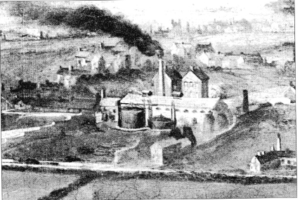VISIT US

House of Recovery
are the two
tall buildings behind the smoking chimney
Voluntary Hospitals began in London; the first ‘The Westminster’ opening in 1719. They were characterised by their independent status and reliance on philanthropy and other private sources of funding. Administration was by committees of lay governors serving in a volunteer capacity and they employed a matron, house surgeon/apothecary, nursing and support staff. Medical expertise was provided largely by physicians and surgeons working in honorary and unpaid posts who dispensed free medical attention and drugs to the poor as out patients.
The movement spread across the country and in July 1802 a meeting was held at the Swan Inn, Hanley to consider “establishing a Medical Dispensary, and a Ward for the reception of Fever Patients.” On the field near to the staircase lock is the site of the first public hospital in North Staffordshire opened in 1804. The inspiration to found a hospital came from local employers including Josiah Wedgwood II. The Dispensary is where patients came for diagnosis, treatment and inoculation against smallpox which had been recently been introduced following the pioneering work of Dr Edward Jenner, in 1796-98. Medical science and the processes of life had been greatly advanced by the work, especially on gases, by such notables as Erasmus Darwin, Joseph Priestley, Humphrey Davy and Antoine Lavoisier, all known personally to the Wedgwood family. The latter had given generous donations to Dr Beddoe’s Pneumatic Institution in Bristol which had treated Tom Wedgwood and the son and daughter of James Watt, and where Humphrey Davy worked. Josiah II offered to rent (purchased in 1812) a plot of land between the Trent and Mersey, and Caldon canals to the committee.
The Staffordshire Advertiser, an influential local newspaper, took up the cause and around £800 was raised, a small amount compared with the £27,000 raised by Derby for their hospital but sufficient to commission Mr Bellhouse of Manchester to draw up the plans for a building comprising two parallel wings and to commence constructed by Mr Coxon of Hanley. Additional funds were raised, including a legacy of £800 and Josiah Wedgwood II became treasurer with the accounts being handled at his manufactory pro bono. The Dispensary opened in April 1804 and the eleven-bed House of Recovery, a euphemism for a fever ward, shortly after. Later it was decided to admit general and accident patients so providing an infirmary. Additional building work was undertaken.
The paid employees consisted of an apothecary, who was in effect the general practitioner attending patients, dispenser of medicines and secretary to the trustees, a matron, and a small number of nurses and support staff. The work consisted of dealing with general illness, diseases caused by lead and dust and accident cases related to the pottery, mining and iron industries. Good work on the prevention of illness progressed with a program of vaccination against smallpox, and encouragement to factory and mine owners to improve safety.

The institution continued to operate until 1819 when it had been realised that larger buildings were required and the site was not suitable for expansion. A new infirmary was erected in Etruria close to the Newcastle to Leek road with much better access. The new institution operated until 1869 when it was moved to the healthy and quiet suburb of Hartshill. It became the North Staffordshire Royal Infirmary and with the City General Hospital is now the University Hospital of North Staffordshire.
